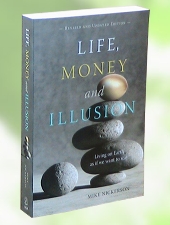The whole story:

Life, Money
and Illusion
A Most Potent Action for Securing the Future
When someone says that youth is the hope of the world, there is scientific proof that stands up in any age.
Young minds can understand new situations easier than older people. How many times do we hear that if one has trouble with some new electronic device that one best ask a young person for help?
Educators have long known that it is much easier for a child under the age of four to learn a second language than it is for an adult. This is because the part of the brain that learns language is still forming at the early age. The nerves are not yet coated with the myelin material that makes them faster, but slows down the rate at which they can make new connections.
This same process, of being able to learn things more easily before the myelin coating develops, characterizes the frontal lobes in the brains of young adults. The frontal lobe is the part of the brain that recognizes how different aspects of the world work and makes decisions about how one will act in various circumstances. This part of the brain does not get its myelin sheathing until well into a person's 20s.
A young adult today who becomes familiar with the criteria of sustainability will be capable of working comfortably with those criteria throughout their lives. The likelihood is great that they will come up with new, inventive, creative ways to meet the challenge of adapting to humanity's new circumstances on Earth. The lives awaiting them is motivation to take such seeds and grow them into a truly sustainable civilization.
When opportunites arise to speak with young adults, these Key Messages are at the top of the list.
Becoming familiar with the frame-of-reference advances the challenge of sustainability in a number of ways.
A Simple Exercise:
The background needed to engage young minds in the challenge of our times can be introduced by providing the criteria below and encouraging them to pick them apart.
- Are these eight points really an outline of sustainability?
- If not, what point or points are mistaken?
- For what reasons?
- Is there anything missing?
Well-being can be sustained when activities:
1) Use materials in continuous cycles.
2) Use continuously reliable sources of energy.
3) Come mainly from the qualities of being human (i.e. creativity, communication, coordination, appreciation, and spiritual and intellectual development.)
Long-term well-being is diminished when activities:
4) Require continual inputs of non-renewable resources.
5) Use renewable resources faster than their rate of renewal.
6) Cause cumulative degradation of the environment.
7) Require resources in quantities that undermine other people's well-being.
8) Lead to the extinction of other life forms.
Can you find the mistake?
Can your students?
To be really effective, suggest to your students that they may be asked to recollect these points, or their revised version, at a later date. (It is not necessary to actually distract examination space with such a question; the point is to stimulate some critical thinking around these points.)
The approach we propose doesn't assume that we understand the challenge fully. While we haven't been able to find any mistakes yet, we would like to hear from anyone who does. In any case, thinking them through will familiarize anyone with the challenge of our times.
More detail about each point can be found here.
A short history of where the outline comes from is posted here.
